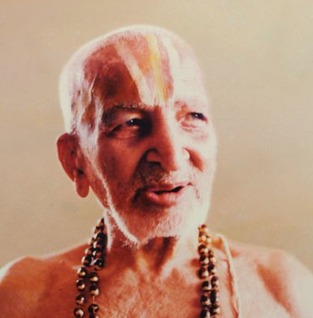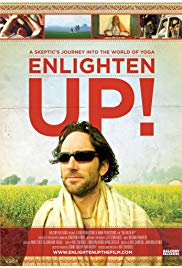
K. Pattabhi Jois was an Indian yoga guru who developed and popularized the flowing style of yoga as exercise known as Ashtanga vinyasa yoga. In 1948, Jois established the Ashtanga Yoga Research Institute in Mysore, India. Pattabhi Jois is one of a short list of Indians instrumental in establishing modern yoga as exercise in the 20th century, along with B. K. S. Iyengar, another pupil of Krishnamacharya in Mysore. Jois sexually abused some of his yoga students by touching inappropriately during adjustments. Sharath Jois has publicly apologised for his grandfather's "improper adjustments".

Ashtanga vinyasa yoga is a style of yoga as exercise popularised by K. Pattabhi Jois during the twentieth century, often promoted as a dynamic form of classical Indian (hatha) yoga. Jois claimed to have learnt the system from his teacher Tirumalai Krishnamacharya. The style is energetic, synchronising breath with movements. The individual poses (asanas) are linked by flowing movements (vinyasas).

Tirumalai Krishnamacharya was an Indian yoga teacher, ayurvedic healer and scholar. He is seen as one of the most important gurus of modern yoga, and is often called "Father of Modern Yoga" for his wide influence on the development of postural yoga. Like earlier pioneers influenced by physical culture such as Yogendra and Kuvalayananda, he contributed to the revival of hatha yoga.

Sun Salutation, also called Surya Namaskar or Salute to the Sun, is a practice in yoga as exercise incorporating a flow sequence of some twelve linked asanas. The asana sequence was first recorded as yoga in the early 20th century, though similar exercises were in use in India before that, for example among wrestlers. The basic sequence involves moving from a standing position into Downward and Upward Dog poses and then back to the standing position, but many variations are possible. The set of 12 asanas is dedicated to the Hindu solar deity, Surya. In some Indian traditions, the positions are each associated with a different mantra.
The Mysore style of asana practice is the way of teaching yoga as exercise within the Ashtanga Vinyasa Yoga tradition as taught by K. Pattabhi Jois in the southern Indian city of Mysore; its fame has made that city a yoga hub with a substantial yoga tourism business.
The Yoga Korunta or Yoga Kuruntha is a purported 5,000 year old text on yoga, said to have been written in Sanskrit by an otherwise unknown author, Vamana Rishi, allegedly discovered by Tirumalai Krishnamacharya in the National Archives of India in the early 20th century, and supposedly lost when Krishnamacharya's only copy was eaten by ants.
A vinyasa is a smooth transition between asanas in flowing styles of modern yoga as exercise such as Vinyasa Krama Yoga and Ashtanga Vinyasa Yoga, especially when movement is paired with the breath.

Larry Schultz was an American yoga teacher who was a long-time student of the founder of Ashtanga Vinyasa Yoga, K. Pattabhi Jois. Schultz is primarily recognized as the creator of Rocket Yoga, a style derived from Jois's, which is known to be one of the original forms of Vinyasa Flow or Power Yoga.
Tim Miller is an American teacher and author on the Ashtanga Vinyasa Yoga style of yoga as exercise.
Power Yoga is any of several forms of energetic vinyasa-style yoga as exercise developed in America in the 1990s. These include forms derived from Ashtanga Vinyasa Yoga, namely those of Beryl Bender Birch, Bryan Kest, and Larry Schultz, and forms derived from Bikram Yoga, such as that of Baron Baptiste.

Sharon Gannon is a yoga teacher, animal rights advocate, musician, author, dancer and choreographer. Along with David Life, she is the co-founder of the Jivamukti Yoga method.
Beryl Bender Birch is a teacher of yoga as exercise and a creator and guru of Power Yoga.
Bryan Kest is an American yoga teacher. Recognized as the creator of one form of Power Yoga, he is the founder of Santa Monica Power Yoga, based in Santa Monica, California. Kest has led yoga classes, retreats and workshops worldwide. He is credited with pioneering the practice of donation-based yoga in the United States.

André Van Lysebeth was a Belgian yoga instructor and author whose books about yoga have been translated into many languages. He is also known for a quintessential book on human sexuality he took thirty years of his life to write, Tantra: The Cult of the Feminine.
R. Sharath Jois is a teacher, practitioner and lineage holder (paramaguru) of Ashtanga Yoga, in the tradition of his grandfather K. Pattabhi Jois. He is the director of Sharath Yoga Center in Mysore, India.
Kino MacGregor is a notable American Ashtanga Yoga teacher, author, entrepreneur, influencer, inspirational speaker, and video producer. When she was 29, K. Pattabhi Jois certified her to teach Ashtanga Yoga.

Sexual abuse by yoga gurus is the exploitation of the position of trust occupied by a master of any branch of yoga for personal sexual pleasure. Allegations of such abuse have been made against modern yoga gurus such as Bikram Choudhury, Kausthub Desikachar, Yogi Bhajan, Amrit Desai, and K. Pattabhi Jois. There have been some criminal convictions and lawsuits for civil damages.

Enlighten Up! is a 2009 documentary film by Kate Churchill on yoga as exercise. It follows an unemployed journalist for six months as, on the filmmaker's invitation, he travels from the US to India to practise under yoga masters including Pattabhi Jois, his first American pupil Norman Allen, and B. K. S. Iyengar.

Postural yoga began in India as a variant of traditional yoga, which was a mainly meditational practice; it has spread across the world and returned to the Indian subcontinent in different forms. The ancient Yoga Sutras of Patanjali mention yoga postures, asanas, only briefly, as meditation seats. Medieval Haṭha yoga made use of a small number of asanas alongside other techniques such as pranayama, shatkarmas, and mudras, but it was despised and almost extinct by the start of the 20th century. At that time, the revival of postural yoga was at first driven by Indian nationalism. Advocates such as Yogendra and Kuvalayananda made yoga acceptable in the 1920s, treating it as a medical subject. From the 1930s, the "father of modern yoga" Krishnamacharya developed a vigorous postural yoga, influenced by gymnastics, with transitions (vinyasas) that allowed one pose to flow into the next.
Post-lineage yoga, also called non-lineage yoga, is a contemporary form of yoga practised outside any major school or guru's lineage. The term was introduced by the ethnographer and scholar-practitioner Theodora Wildcroft. She stated that with the deaths of the pioneering gurus of modern yoga such as B. K. S. Iyengar and Pattabhi Jois, yoga teachers, especially women, have been reclaiming their practice through their yoga communities, resisting commercialization as well as lineage.











